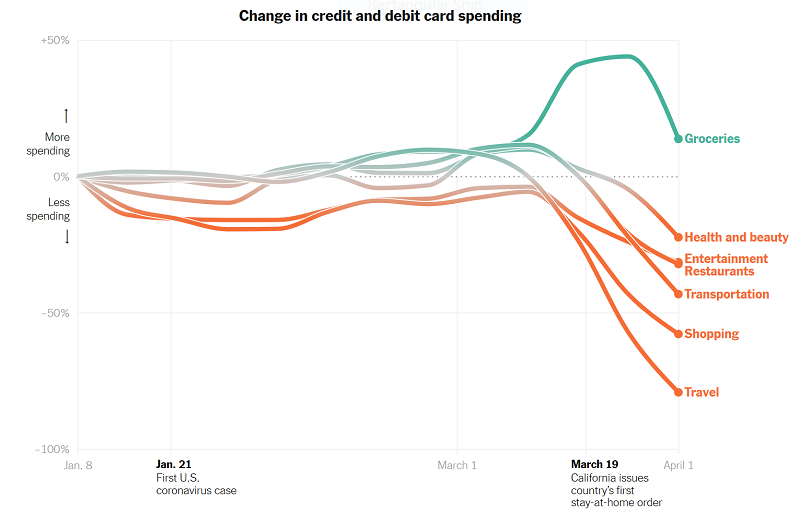
By Steve Cavolick
Two of the best and most common applications of analytics are customer acquisition/retention/growth and risk management. Given today’s realities, these use cases have never been more important. Coronavirus has turned the world upside down. Billions of people are locked down to reduce the spread of the virus, and the world economy has nearly ground to a halt. As a result, traditional business models and supply chains have been destroyed.
Let’s look at just a few of the unprecedented changes in business that have occurred since the pandemic took hold:
As an economic barometer, retail spending was down nearly 9% in March. But the way we are spending our money since the pandemic started has also changed, and it is sending tidal waves through the economy. The trends can be seen in this graph from The New York Times:

Risk has increased and purchasing patterns are changing. The two most important things business leaders can do right now are to remain focused on the corporate mission and to maintain flexibility in seeing that the current long-term plan needs to evolve. Clearly, applying triage to the business in the short-term must be done first, but the best leaders are going to redefine the future of their companies by seeing new markets, customers, partners, and innovations first, and acting on those in order to adjust to the emerging business models.
Being able to identify those things quickly and act on them now could mean the difference between a company’s survival and decimation. This is where trusted data and analytics will shine.
Were you able to make mission-critical decisions when things changed because of the pandemic? Did your company’s data present you with an enterprise and prescriptive view? Or did you require 12 business analysts to munge data together in spreadsheets for days and days while you hemorrhaged cash and sat paralyzed?
We’ve said it before in other blog posts: the path of your analytics journey should ultimately be focused on delivering AI, but you can’t have AI without IA (information architecture). Even if you are not using AI today, the information architecture you need to organize your data for AI gives you the agility to react to changing conditions through traditional analytics. With organized and trusted data, you can see and manage risk while discovering new markets. Examples of such applications include:
- Monitor Employee Health: Do you have the proper continuity plans in place if key employees become sick? Protect your employees and business by reporting on well-being and who is sick.
- Supply Chain Scenarios: Prepare contingency plans based on predictive scenarios on supplier availability with impacts to margins and cost.
- Examine Contracts: How much risk do you carry in your contracts? Text analytics can be used to understand the financial, operational, and legal exposure your company has to non-compliance or non-payment.
- Supplier Risk Analysis: Can you predict when your supplier will not be able to deliver critical components? What about your supplier’s supplier? Knowing who your backup suppliers are in times of crisis means the business can continue without delays.
- Inventory Review: What do you really know about your inventory? Do you know your fastest and slowest movers? Where are you going to repurpose old or suddenly obsolete inventory?
- Optimize Your Teams For The Future: Where are the skills gaps in your company? Which team leaders don’t react well to rapid change? Use this data to fix the problem teams or geographies.
Helping organizations collect, organize, and analyze their data is what we do. Let us help you achieve data nirvana. Not sure how to get started? Our strategic offerings can help you align business and technology teams, discover right use case, and determine an ROI.
The LRS Big Data and Analytics team has over 20 years of experience in analytics, information management, and data warehousing. If you are interested in understanding how we can help you find value in your data, please fill out the form below to request a meeting.
About the author
Steve Cavolick is a Senior Solution Architect with LRS IT Solutions. With over 20 years of experience in enterprise business analytics and information management, Steve is 100% focused on helping customers find value in their data to drive better business outcomes. Using technologies from best-of-breed vendors, he has created solutions for the retail, telco, manufacturing, distribution, financial services, gaming, and insurance industries.